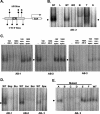Functional characterization of a testis-specific DNA binding activity at the H19/Igf2 imprinting control region
- PMID: 14585991
- PMCID: PMC262389
- DOI: 10.1128/MCB.23.22.8345-8351.2003
Functional characterization of a testis-specific DNA binding activity at the H19/Igf2 imprinting control region
Abstract
The DNA methylation state of the H19/Igf2 imprinting control region (ICR) is differentially set during gametogenesis. To identify factors responsible for the paternally specific DNA methylation of the ICR, germ line and somatic extracts were screened for proteins that bind to the ICR in a germ line-specific manner. A specific DNA binding activity that was restricted to the male germ line and enriched in neonatal testis was identified. Its three binding sites within the ICR are very similar to the consensus sequence for nuclear receptor extended half sites. To determine if these binding sites are required for establishment of the paternal epigenetic state, a mouse strain in which the three sites were mutated was generated. The mutated ICR was able to establish a male-specific epigenetic state in sperm that was indistinguishable from that established by the wild-type ICR, indicating that these sequences are either redundant or have no function. An analysis of the methylated state of the mutant ICR in the soma revealed no differences from the wild-type ICR but did uncover in both mutant and wild-type chromosomes a significant relaxation in the stringency of the methylated state of the paternal allele and the unmethylated state of the maternal allele in neonatal and adult tissues.
Figures




References
-
- Bell, A. C., and G. Felsenfeld. 2000. Methylation of a CTCF-dependent boundary controls imprinted expression of the Igf2 gene. Nature 405:482-485. - PubMed
-
- Bourc'his, D., G. L. Xu, C. S. Lin, B. Bollman, and T. H. Bestor. 2001. Dnmt3L and the establishment of maternal genomic imprints. Science 294:2536-2539. - PubMed
-
- Davis, T. L., J. M. Trasler, S. B. Moss, G. J. Yang, and M. S. Bartolomei. 1999. Acquisition of the H19 methylation imprint occurs differentially on the parental alleles during spermatogenesis. Genomics 58:18-28. - PubMed
Publication types
MeSH terms
Substances
LinkOut - more resources
Full Text Sources
Other Literature Sources
Molecular Biology Databases
Miscellaneous
